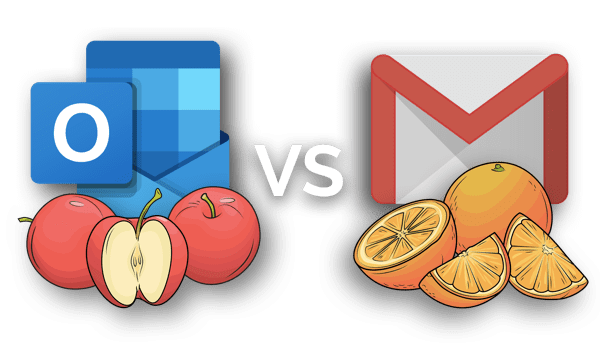Cloud Technology
Google Workspace
Microsoft 365Outlook vs. Gmail: Comparing Apples to Oranges
What if we told you that comparing Microsoft Outlook with Gmail is like comparing apples with oranges? Find out why comparing these two email systems is an exercise in futility.
By
Spanning Cloud Apps
4 minute read
*Approximately 57,000,000 Google search results show up if you enter a search for ‘Microsoft Outlook vs. Gmail’. Yet, none of these pages explain why Microsoft Outlook and Gmail cannot be looked upon in the same light. In essence, it’s like comparing apples to oranges!* On the surface, both Microsoft Outlook and Gmail seem similar. After all, they both send and receive emails. However, it’s how each of these work that makes them so different.
On the surface, both Microsoft Outlook and Gmail seem similar. After all, they both send and receive emails. However, it’s how each of these work that makes them so different.
The truth of the matter is, Microsoft Outlook is an email client while Gmail is essentially webmail.
What Is an Email Client?
An email client is a computer program that downloads your emails from the server to your computer, from which you can read and send emails. Emails can be accessed without an internet connection since all the messages are saved on the computer. Microsoft Outlook, Apple Mail and Thunderbird are a few popular email clients.
What Is Webmail?
Webmail is an interface provided by an ISP (Internet Service Provider) or corporate custom domain where all elements of the email system like inbox, calendar services and contacts are accessed by the web browser. Users can access emails from anywhere at anytime as long as they have an internet connection. Gmail, AOL Mail, Outlook.com and Yahoo! Mail are a few well-known webmail services.
Fun fact – Webmail can be accessed through an email client as well!
For instance, you can run Gmail on Outlook with Google Workspace Sync for Microsoft Outlook and access Gmail, calendar and contacts with Outlook on Windows OS.
Watch this video to get a more in-depth understanding of the difference between an email client and webmail.
Outlook Vs. Gmail – Which Is Better?
Microsoft Outlook and Gmail both have their benefits and shortcomings, making them better (or worse) than the other depending on your needs.
Why Microsoft Outlook Is Better
No more an Internet slave
For most people who are constantly on the move, a constant internet connection is a bit of a luxury. It isn’t scalable for professionals and businesses to depend on the availability of WiFi to get tasks done. Microsoft Outlook allows access to emails even when you’re offline. Write a response and have it ready to send, and once you’re online the email will be sent out automatically.
Manage multiple email accounts like a boss!
Microsoft Outlook does a great job of prioritizing, categorizing, filtering and flagging emails from multiple addresses with different domains. That means you can check messages from your Hotmail, Yahoo or Gmail account all from one place.
Why Gmail Is Better?
Gmail aces it when it comes to providing the same experience every time you log into your account, regardless of the device or location.
Avoid manual customization
Customizing categories, filters, behaviors, identities and signatures across multiple email accounts of different domains may be fun if it involves just one device but applying the same customization across multiple machines can be incredibly tedious and time-consuming, not to mention error-prone. However, Gmail comes up trumps in this aspect since it can be customized across multiple machines in one go.
Outlook vs. Gmail – Security Is the Common Blindspot
Whether you prefer a reliable email client like Outlook or easy-to-use webmail like Gmail, securing your data should be a priority regardless.
Although Microsoft and Google have the best security in place to protect your data from infrastructural threats like hardware or software failure, power outages, or natural disasters, they cannot protect you from attacks originating at your end, such as human error, sync errors, malicious insiders, illegitimate deletion requests, malware and ransomware, to name a few.
Spanning’s cloud-native, purpose-built solutions for Microsoft 365 and Google Workspace protect your organization’s critical data from loss and is unique in its ability to enable end-users as well as administrators to quickly find and restore data to its original state in just a few clicks.
Select a platform below to see how Spanning helps protect Outlook and Gmail.
Outlook Backup
Gmail Backup